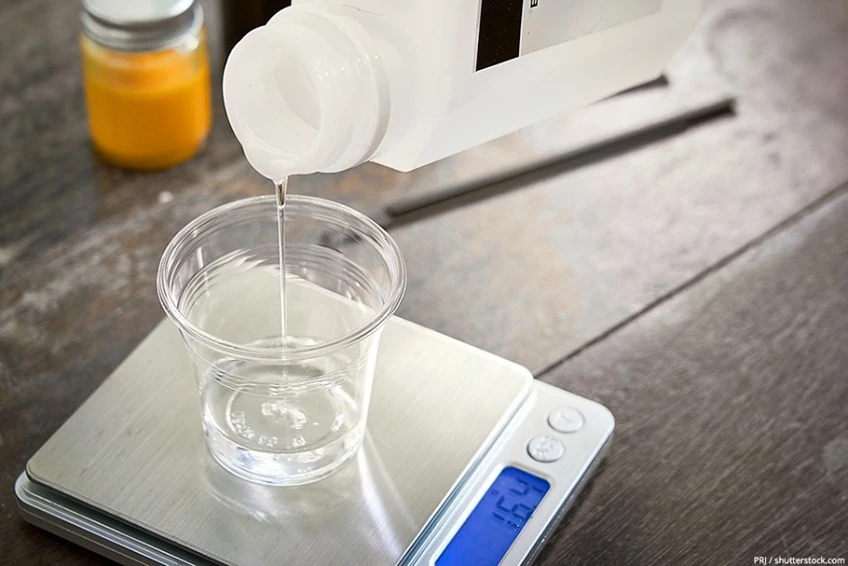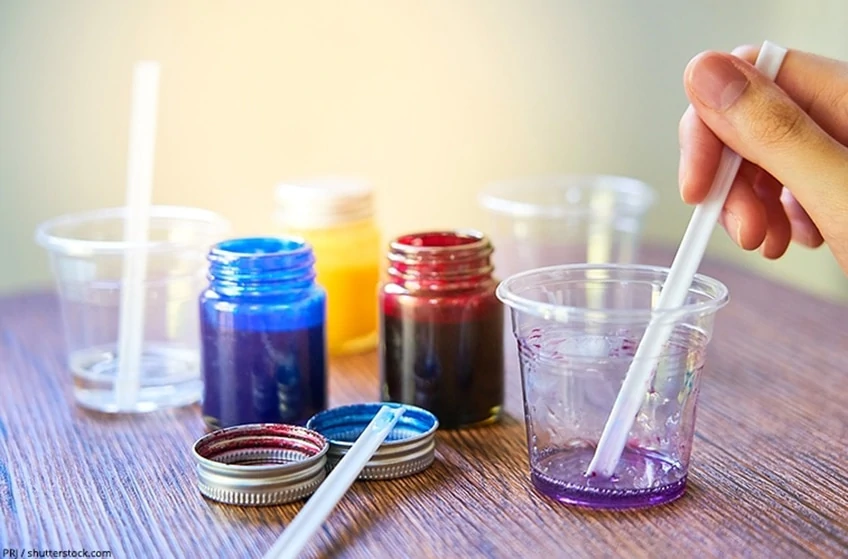What is Resin Made of – Epoxy Resin Compared to Polyester Resin
This post may contain affiliate links. We may earn a small commission from purchases made through them, at no additional cost to you. You help to support resin-expert.com
The word “resin” refers to a broad range of both naturally occurring and manufactured compounds. For the purposes of this discussion, we will be focusing on the types of highly versatile plastic-like substances commonly known as epoxy and polyester resins. Epoxy resin is typically packaged as two separate compounds – a resin and a hardener – that must be mixed to initiate the setting process and produce what will become a solid plastic-like substance. Polyester resins are sold as a single substance that hardens with the application of either a chemical catalyst or under UV light. To help you identify whether your project requires resin, and which type to use, we have provided a brief overview of what resin is, and what its applications are.
Table of Contents
Resin at a Glance
So, what is resin? Natural resins are substances secreted by plants to create a protective barrier following injury. Likewise, synthetic resins are used to produce highly effective coatings, structural adhesives, and composites. Resins therefore come in a wide variety, ranging from thinly layered coating resins to liquid casting resins for producing completely solid plastic-like components. In industry, resins are widely used for a very broad range of applications. For DIYers and crafters, resins provide not only coating and adhesive possibilities, but also enable the production of entirely new and customized pieces.
Types of Resin
In a DIY or craft setting you will have to the choice of using either an epoxy or a polyester resin. These resin types differ not only in the process by which they harden, but also in their protective, adhesive, and structural properties.
So, what is the difference between epoxy and polyester resin? The main difference lies in how they cure. Epoxy requires a special hardener while polyester uses a catalyst for the chemical reaction that speeds up its curing process. Epoxy will only start to cure once the hardener has been mixed in. With polyester resin, the manufacturer has already combined the resin with a hardener, but at a ratio where although the curing process is already underway, it is at an extremely slow rate. Hardening this resin therefore requires a catalyst, which can be either a chemical or the application of UV light. This is also why polyester resin has an expiration date.
In terms of properties, polyester resin bonds to a roughened surface at a proximate level. In other words, polyester adheres to a surface because the strong internal structure of the cured resin is close enough to a textured surface to be able to cling to it (a bit like creating microscopic jigsaw pieces). Epoxy works like this as well, but in addition, it also forms ionic bonds with other materials at an atomic level. Epoxy is therefore the far stronger of the two resin types. However, there are circumstances where polyester is preferable to epoxy. We will discuss each of these resin types below.
Epoxy Resin
Epoxy resin is a special substance with particularly strong properties. This resin is known for its chemical resistance and its excellent adhesive qualities. If you need a very durable resin product, then epoxy is the best option to consider. Due to its strong finish and good adhesion qualities, this resin is ideal for a wide range of applications.
Benefits of Epoxy Resin
Epoxy resin is used in sealants, varnishes, casting and caulking compounds, paints, and all sorts of other industrial applications. Epoxy does not shrink when curing, making it an ideal casting resin and gap-filling substance. It is also resistant to moisture and chemicals, has electrical insulating properties, and is very impact resistant. For large items and added strength it can also be reinforced with fibers and other structural enhancements.
In addition to its superior adhesive properties, epoxy resin has a high weight to strength ratio which makes it an excellent option for resin casting projects. This characteristic, combined with its ability to bond to other materials, also makes it very useful for filling gaps as it can generally be sanded and shaped after curing.
Drawbacks of Epoxy Resin
Epoxy resin is not UV resistant. This is a particular problem in epoxy paint which will yellow and start to resemble chalk after too much sun exposure. While epoxy is water resistant and will set in water, some types of epoxy resin is porous, meaning that it is not waterproof.
Epoxy coatings cannot receive a gelcoat, and although an epoxy coating will adhere to a polyester resin surface, the inverse is not the case. Epoxy only cures gradually, so full strength can take a while to achieve.
Polyester Resin
While epoxy is formed when a resin is mixed with a hardener, polyester resin is the result of a chemical reaction that occurs when dibasic organic acids are mixed with polyhydric alcohols. The result is a strong plastic substance with similarities to epoxy, but also some significant differences. Since the chemical reaction that produces polyester resin requires a catalyst, the speed at which the reaction occurs can be controlled and this resin can cure very quickly. Unlike epoxy, polyester is not weakened by exposure to UV, so ultraviolet curing can be applied to polyester resin, eliminating the need for measuring and mixing catalytic chemicals.
Benefits of Polyester Resin
Polyester resin has superior waterproofing properties. It is highly resistant to corrosion, rust, and acidic substances. It can also withstand very high heat. Polyester epoxy paints are therefore used as powder coatings in white goods such as washing machines. It is also very useful in primers, particularly for marine applications and for coating surfaces exposed to harmful chemical and acids.
Unlike epoxy, polyester resin does not bond with another material at an atomic level. The adhesive quality of polyester resin is therefore inferior to epoxy. It does, however, have good wetting qualities, and low shrinkage, which means that it is used with great effect in conjunction with structural enhancements such as glass fibers to produce solid plastic shell structures.
Drawbacks of Polyester Resin
Polyester resin is not as strong as epoxy. So, you will need to decide if you require more waterproofing or more bonding and strength for your final project. It is also less effective as a gap filling resin than epoxy.
Unless you are using UV cured polyester resin, it is essential that the catalytic agent is applied with precision. If too much is used, then you risk charring the material which can leave you with a brittle or rubbery substance. The chemicals used to make polyester resin are highly toxic, so you must wear proper protection when working with it. In addition, some polyester resins require both a catalyst and the application of heat to cure, so working with it can be dangerous.
While UV cured resin does eliminate this problem, the penetration of the UV light into the substance is limited, so you can only apply UV cured resin one thin layer at a time. It is therefore not an option if you need a casting resin. It is, however, very useful if you are applying a protective layer on a small delicate object, as polyester resins are less likely to yellow over time than epoxy coatings.
Because polyester resins are more likely to be shipped in a pre-mixed or ‘promoted’ form where curing is already underway, this resin cannot be stored indefinitely and must be used within the manufacturer’s stipulated timeframe. So be sure to buy only as much as you will need for a specific project at a time.
Epoxy Resin vs. Polyester Resin
For easy reference purposes, we have provided a brief comparison of epoxy and polyester resins below:
| Properties | Epoxy Resin | Polyester Resin |
| Strength | Very strong | Quite strong, but weaker than epoxy |
| Durability | Highly durable, and chemical resistant but will degrade under UV light | Highly durable and rust, corrosion, chemical, and UV resistant |
| Waterproof | Water resistant, but not all epoxies are waterproof | Waterproof. Ideal for marine applications |
| Adhesion | Excellent. Bonds at an atomic level | Good on a well-prepared surface. Bonds at a proximate level |
| Toxicity | Can cause skin irritation with repeated exposure | Can be very toxic. Safety gear required |
| Curing time | Cures slowly | Cures quickly, but can be determined by the amount of catalyst used |
| Ease of use | Requires correct measuring, but not too difficult to use | Can be tricky to use |
Using Resin
Some types of resin are very easy to use and require minimal preparation and caution. Others are more complicated and potentially harmful if the right processes are not followed. Below is a brief overview of the main types of resins you can expect to encounter, and what to keep in mind when using them.
Manufacturers vs. Formulators
When buying any type of resin, it is important to know that manufacturers of resins sell their products predominantly to large industrial clients. The adhesives, coatings, and other forms of resin available to the average consumer are sold by not by the primary manufacturers of resins, but by companies that use these resins to create their own unique formulations. Each company (or formulator) adds different substances to modify the resins they use for reasons ranging from enhancing cost-effectiveness to convenience. As a result, not all resin products of the same type will perform equally. So, before you buy, make sure that the brand you choose is the one best suited to your specific needs.
Epoxy Adhesives
Epoxy adhesives come in various forms ranging from very liquid to putty-like substances. Any type will require mixing of resin with hardener. If you are not habitually precise, you will benefit from choosing a product that makes mixing easy, such as an epoxy with a mixing ratio of 1:1 or one that comes in packaging designed to release the same amount (like two joined syringes). Remember, if you use too much hardener, your bond will be weak, if you use too much resin, your bond may never fully cure. Always ensure that the surface you want to glue is clean of any other substances. Key all bonding surfaces by sanding them to create some texture.
Epoxy hardeners can be toxic, while epoxy resins are classed as irritants, so it is best to avoid getting too much epoxy adhesive on your skin. Putty-like epoxy adhesives are designed to be manipulated while uncured, so keep in mind that while immediate toxicity is unlikely, prolonged contact can result in allergic dermatitis. If you use putty epoxy frequently, wear gloves. Also, do not sand or drill into epoxy before it has completely cured as this dust can be toxic if inhaled.
Polyester Adhesive
While epoxy is the superior resin type for adhesion, the convenience of UV cured resin means that there is a good polyester adhesive option. By applying thin layers of resin, and then curing them under a UV light an object can be repaired without having to go the messy route of mixing and applying an epoxy adhesive. Remember, that since the resin used for this type of glue is a premixed polyester, it is already in the process of curing. This means that the liquid component in a UV adhesive kit will eventually cure in the tube unless you use it before its expiration date.
Epoxy Coatings
If you need a very strong and hardwearing coating, then an epoxy-based varnish or sealant is ideal. However, keep in mind that while epoxy is water resistant, some types are sufficiently porous to not be entirely waterproof. Therefore, in a marine setting, epoxy coatings are better used inside the boat. Epoxy that is exposed to high levels of UV may also degrade over time, resulting in it taking on a chalky appearance.
As with adhesives, ensure that all surfaces to be coated are clean, free from rust, paint, or oils, and have been lightly sanded to promote adhesion. Depending on the formula used, the toxicity of epoxy coatings can vary, so take the precautions suggested on the packaging.
Epoxy does have a longer curing time than polyester. While you will ultimately end up with a very strong and durable surface, you may need to wait a while before the coating reaches its toughened state. So do not apply an epoxy coating to an item if you need to use it immediately.
You can use epoxy resin as a medium for pigment in art and craft, but remember that epoxy will eventually yellow slightly, which may affect the color over time. This factor may be outweighed by the fact that it is far easier and less toxic to use epoxy resin in art and craft than polyester resin.
Polyester Coatings
If you want a coating that is waterproof, rust, corrosion, and heat resistant, then a polyester resin coating is ideal. Polyester resin makes for an ideal primer or undercoat and receives a gelcoat very well. Epoxy will also adhere to polyester, so if you need a waterproof surface that is also very strong, then you can undercoat with polyester and finish with epoxy. Just remember, that this surface should not have direct sun exposure, or the UV in sunlight will degrade the epoxy.
As polyester resin does not bond as easily as epoxy, optimum surface preparation is essential. Also, polystyrene resin is quite toxic and emits very strong odors, so work in a well-ventilated area and wear protective clothing. One major benefit is that polyester sets very quickly, so you will not have an extended drying time.
Casting Resins
When casting resin preparation is key. Make sure that you work in a well-ventilated space, especially when working with polyester resin. Lay down a drop cloth or some paper to protect any surfaces and set out gloves, goggles, and a respirator if your resin has a hardener, catalyst, or initiating agent with a strong odor. If your resin requires heat to mix or set, ensure that all flammable items are kept clear of your work area.
When preparing your molds, ensure that they are sufficiently supported so they will not tip or leak when the resin is poured. Also, unless you’re using silicone molds, always use a release agent to line your mold as both epoxy and polyester resin have strong bonding properties.
When mixing your resins, you will need measuring cups or scales to ensure that you use exactly the correct amounts of each substance. Incorrect ratios will adversely affect your outcome. Always read the instructions as the mixing process can differ from one brand to another.
Remember, while UV cured resin is very convenient and safer to use than other resins, it is not well suited as a casting resin, since UV light cannot penetrate deep enough into your object to cure the resin completely.
Fiberglass
For larger objects, reinforcing elements such as glass fibers can be used. You will use a similar process as when casting resin, except you will need to introduce the fibers once you have created a smooth outer layer, so you will not cast everything at once, but apply your resin in layers. If you choose to use fiberglass it is essential that you protect yourself, as these miniscule glass fibers are both fine enough to inhale, and sharp enough to cause lasting damage to your lungs, airways, and eyes. One benefit of using reinforcing elements is that you can create something quite large that is also strong and durable.
When choosing your resin, use epoxy if you need your object to have more flexibility, but opt for Polyester if you need a stiffer structure.
So, if you were looking for answers to the questions “what is resin?” and “what is resin used for?”, this guide above should have covered everything you needed to know. Resin is a highly useful substance that can be applied to all kinds of applications. For anyone interested in DIY, arts, and crafts, knowing how to use resin can be incredibly useful.
View our What is Resin Made Of web story here.
Frequently Asked Questions
What is Resin Used for?
Resin is a versatile substance that can be used for a multitude of purposes. It is commonly used for making durable castings, arts and crafts, flooring, countertops, and more. Resin can be used to make plastics, and it is an excellent adhesive.
Is Resin a Plastic?
Resin is different from plastic in that plastics have a more synthetic polymer makeup. Some epoxy resins are partially derived from plants. So no, technically, resin is not a plastic. However, there are special plastic resin products available.
Is Resin Made of Plastic?
No, they are different compounds altogether. What’s resin made from then? Resins have plant or synthetic origins that are convertible into polymers. Resin is not made from plastic, even though they share many similar qualities in terms of appearance.
How Strong is Resin?
Different types of resin are available with varying degrees of durability. Epoxy resin is the strongest resin, and it has been designed to withstand all kinds of intense mechanical pressures. This makes epoxy resin suitable for a wide variety of purposes.
Is Resin Harder Than Wood?
While this depends on the type of resin and the type of wood, resin is generally regarded as the stronger substance. Resin is often used as a protective coating over wood, and it can be used to bond two pieces of wood together with great strength.
Is Resin Stronger Than ABS?
What is a resin’s strength compared to ABS? Resin produces a greater level of tensile strength and elasticity when compared to ABS. This makes it a great product for durable and shatter-resistant purposes.





